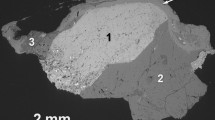Summary
Leogangite, ideally Cu10(AsO4)4(SO4)(OH)6·8H2O, was found on sample material from mine dumps of the Danielstollen and Inschlagalm in the Schwarzleo valley, both part of the polymetallic ore district of Leogang, Salzburg province, Austria. It is intergrown with olivenite and malachite, all together coating small voids within a tennantite-bearing dolomite breccia, and is assumed to have formed as an alteration product of arsenic-rich fahlore. Associated minerals are tyrolite, parnauite, strashimirite, euchroite, brochantite, langite, posnjakite, and devilline. The new mineral crystallizes with monoclinic symmetry, space group C2/c (no. 15), with a=21.770(7) Å, b=12.327(4) Å, c=10.720(3) Å, β=92.85(1)°, V=2873(2) Å3, Z=4, and a calculated density of 3.55 g·cm−3. Leogangite exhibits a thin tabular habit with aggregates of platelets flattened on {100} and elongated along [010], measuring up to 0.1 mm in length, 0.05 mm in width, 0.01 mm in thickness. A perfect cleavage parallel to (100) can be observed. It is transparent, green with a bluish tint, the streak is light green, and it is optically negative with 2V=18(2)°. The refractive indices n x, n y, and n z are 1.590(2), 1.740(2), and 1.744(2), the optical orientation is X=a*, Y=b, Z=c, and the pleochroism is blue-green (X) to pale green (Y, Z). Typical microprobe analyses give (wt%) CuO 49.6–52.9, As2O5 28.5–31.1, SO3 4.9–5.4, which is equivalent to Cu9.94(As0.99Si0.01O4)4(S0.99O4)(OH)6·8.89H2O as the average composition based on 20+3 oxygens. The strongest reflections of the X-ray powder diffraction pattern are (d obs, I/Iobs, hkl): 10.85, 100, (200); 2.630, 60, (\({\it 20}{\bar {\it 4}}\)); 5.44, 50, (400); 3.625, 50, (600); 3.090, 40, (023). The structure of the mineral was refined to R1=0.095 for 1768 unique reflections with \(F^2_{\rm o} > 4\sigma(F^2_{\rm o})\) and is a new representative of the rare [5]-coordinated Cu2+ compounds with edge-sharing CuO5 square pyramids. The main motif consists of [Cu4O14] tetramers. Together with the AsO4 tetrahedra and the remaining CuO5 polyhedron they build complex heteropolyhedral layers parallel to (100), which are linked by the SO4 tetrahedron and parts of the hydrogen bonds along the a-axis, thus forming a complex open framework structure. Chemical, optical and X-ray powder pattern characteristics are the distinguishing features to similar minerals like parnauite, tyrolite, or clinotyrolite.
Similar content being viewed by others
Author information
Authors and Affiliations
Rights and permissions
About this article
Cite this article
Lengauer, C., Giester, G. & Kirchner, E. Leogangite, Cu10(AsO4)4(SO4)(OH)6 • 8H2O, a new mineral from the Leogang mining district, Salzburg province, Austria. Mineralogy and Petrology 81, 187–201 (2004). https://doi.org/10.1007/s00710-004-0032-x
Received:
Accepted:
Published:
Issue Date:
DOI: https://doi.org/10.1007/s00710-004-0032-x



